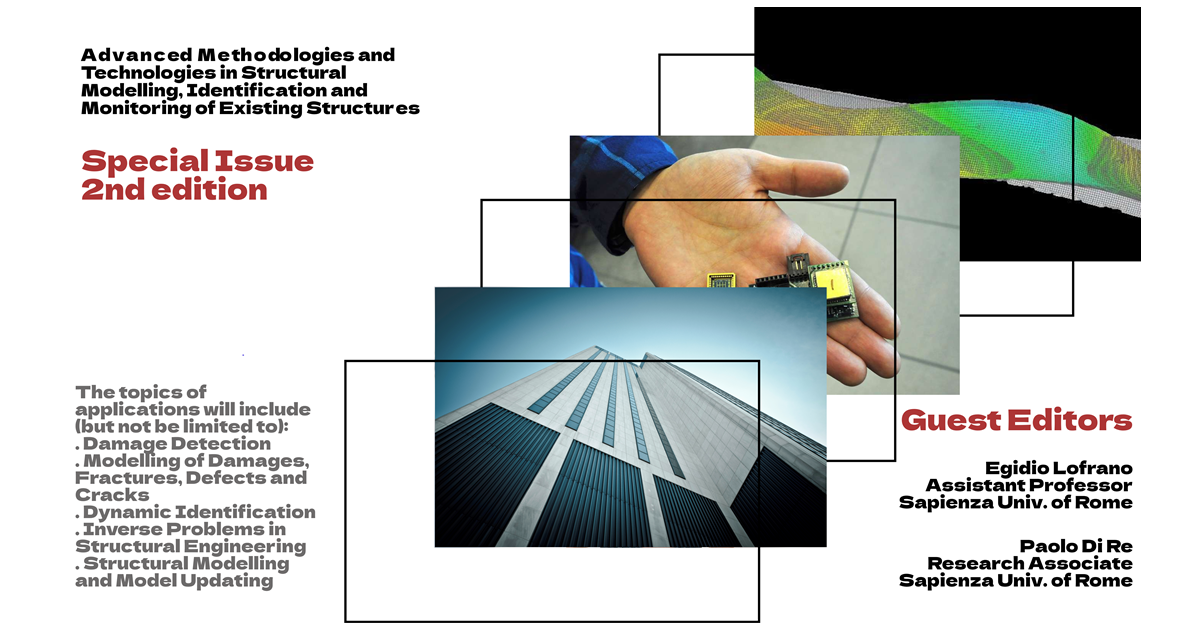Advanced Methodologies and Technologies in Structural Modelling, Identification and Monitoring of Existing Structures—2nd Edition
A special issue of Buildings (ISSN 2075-5309). This special issue belongs to the section "Building Structures".
Deadline for manuscript submissions: closed (31 July 2025) | Viewed by 11117

Special Issue Editors
Interests: thin-walled beams; structural stability; dynamic identification; structural monitoring; damage detection; perturbative approaches; optimal sensor placement; civil engineering
Special Issues, Collections and Topics in MDPI journals
Interests: finite element analysis; computational mechanics; structural analysis; nonlinear modelling; thin-walled beams; masonry structures; monitoring systems
Special Issue Information
Dear Colleagues,
It is a pleasure to announce the 2nd edition of this Special Issue “Advanced Methodologies and Technologies in Structural Modelling, Identification and Monitoring of Existing Structures”. Both methodologies and technological advancements are welcome, as well as specific laboratory or in situ experimental studies or validations. The contributions can focus on the scale of material or structural modelling.
The topics of applications will include (but are not limited to):
- Damage Detection;
- Modelling of Damages, Fractures, Defects and Cracks;
- Dynamic Identification;
- Inverse Problems in Structural Engineering;
- Structural Modelling and Model Updating;
- Machine learning in SHM;
- Sensor Network, Optimal Sensor Placement and Instrumentation Design;
- Sensor Technologies;
- Remote Monitoring.
Dr. Egidio Lofrano
Dr. Paolo Di Re
Guest Editors
Manuscript Submission Information
Manuscripts should be submitted online at www.mdpi.com by registering and logging in to this website. Once you are registered, click here to go to the submission form. Manuscripts can be submitted until the deadline. All submissions that pass pre-check are peer-reviewed. Accepted papers will be published continuously in the journal (as soon as accepted) and will be listed together on the special issue website. Research articles, review articles as well as short communications are invited. For planned papers, a title and short abstract (about 250 words) can be sent to the Editorial Office for assessment.
Submitted manuscripts should not have been published previously, nor be under consideration for publication elsewhere (except conference proceedings papers). All manuscripts are thoroughly refereed through a single-blind peer-review process. A guide for authors and other relevant information for submission of manuscripts is available on the Instructions for Authors page. Buildings is an international peer-reviewed open access semimonthly journal published by MDPI.
Please visit the Instructions for Authors page before submitting a manuscript. The Article Processing Charge (APC) for publication in this open access journal is 2600 CHF (Swiss Francs). Submitted papers should be well formatted and use good English. Authors may use MDPI's English editing service prior to publication or during author revisions.
Keywords
- structural health monitoring
- dynamic identification
- damage detection
- inverse problem
- machine learning in SHM
- sensor network
- optimal sensor placement
- sensor technologies
- remote monitoring
- model updating
Benefits of Publishing in a Special Issue
- Ease of navigation: Grouping papers by topic helps scholars navigate broad scope journals more efficiently.
- Greater discoverability: Special Issues support the reach and impact of scientific research. Articles in Special Issues are more discoverable and cited more frequently.
- Expansion of research network: Special Issues facilitate connections among authors, fostering scientific collaborations.
- External promotion: Articles in Special Issues are often promoted through the journal's social media, increasing their visibility.
- Reprint: MDPI Books provides the opportunity to republish successful Special Issues in book format, both online and in print.
Further information on MDPI's Special Issue policies can be found here.






